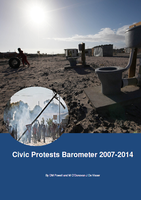South Africa’s violent protests reach the all-time high – MLGI report
This is according to the just published Civic Protest Barometer (CPB) 2007-2014, developed Dr Powell, Michael O’Donovan and Professor De Visser of the Multilevel Government Initiative, an applied research project based at the Community Law Centre in the University of the Western Cape’s. The CPB measures various trends in protest action in South Africa's municipalities, including general trends, geographic spread, incidents and forms of violence, and types of grievances.
The Civil Protest Barometer reveals the following broad trends:
• In 2014 there was an increase in the number of protests, reversing the downward trend that was evident after 2009.
• The number of protest in 2014 reached an all-time-high of 218. The previous maximum was 204 in 2009 (which was also an election year).
• The increase in 2014 is only partly due to the election held on May 7. Although April and May saw 25 and 30 protests respectively, almost as many protests (28) took place in August, three months after the election.
• In the three year period 2012 - 2014 Gauteng experienced more protests than any other province. Since 2007 Gauteng's share of protests has been rising more rapidly than any other provinces'.
• Cape Town was the most the most protest-prone municipality with 84 protests, followed by Johannesburg, eThekwini, Tshwane and Ekurhuleni. Between them these five metro municipalities accounted for half of all the protests recorded.
• Issues relating to municipal services and the administration of municipalities were cited more often as cause of protests than all other grievances put together.
The data from the CPB covers the period 2007 to 2014 (inclusive) and tracks four variables
1. trends in the number of protests: 2007 to 2014
2. geographical spread of protest: 2007 to 2014
3. trends in violent civic protest: 2007 to 2014
4. grievances behind protest action: 2012 to 2014
In addition the barometer tests one hypothesis about the causes of protests, namely that it signals a “rebellion of the poor”, against the empirical data.
The barometer introduces a new definition of the protest action, “civic protests,” which is a sub-category of the concept of “civic conflict” that is used in the international literature on conflict to distinguish serious conflict that is not civil war or war between states. In our context civic protest is given a narrow definition, referring to organized protest action within a local area which directly targets municipal government or targets municipal government as a proxy to express grievances against the state more widely.
Understanding the protests as a form of civic conflict locates the South African experience within the broader field of comparative international scholarship on conflict in fragile and conflict affected countries, which is useful for purposes of comparative research. Internationally, civic conflict is regarded as a symptom of both social exclusion and fragile state institutions.
The link between civic protests and the quality of state institutions is apposite. The South African Constitution creates obligations on the state to put people, and especially the poor and vulnerable, at the center of government and social policy. The regime for developmental local government in the constitution demands responsive, accountable and inclusive local government. Systemic civic conflict is incommensurate with the constitutional commitment to building developmental local government and thus a signal of institutional decay and a breach of constitutional obligations.
Report
Technical Note


